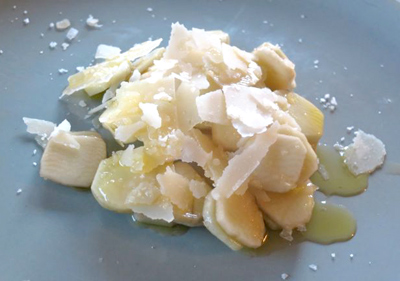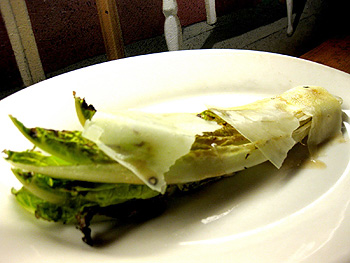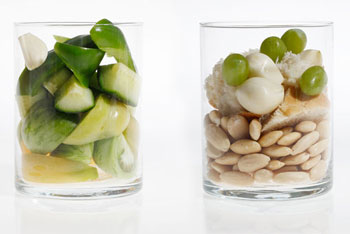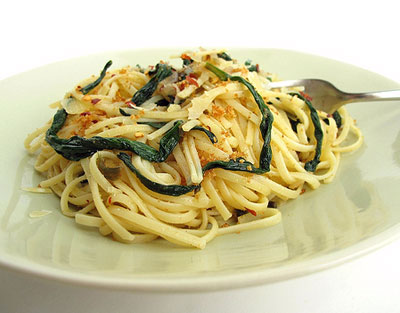 People say we don’t have seasons in LA. Oh but we do my friends, we do. For example, now is Artichoke Season, a time when (if you’re lucky) you can find a farmer harvesting huge heavy artichokes with a long stem still attached. The artichoke head that we eat is the bud stage of a giant gorgeous purple flower. As the artichoke ages the “leaves” of the bud open ultimately revealing the choke which turns deep lavender. For eating you want the bud pretty tightly closed. And look for heavy artichokes. Heaviness means freshness. When the artichoke is freshly cut it’s cells are full of water. As time goes by the water transpires and evaporates leaving the vegetable light and dry.
People say we don’t have seasons in LA. Oh but we do my friends, we do. For example, now is Artichoke Season, a time when (if you’re lucky) you can find a farmer harvesting huge heavy artichokes with a long stem still attached. The artichoke head that we eat is the bud stage of a giant gorgeous purple flower. As the artichoke ages the “leaves” of the bud open ultimately revealing the choke which turns deep lavender. For eating you want the bud pretty tightly closed. And look for heavy artichokes. Heaviness means freshness. When the artichoke is freshly cut it’s cells are full of water. As time goes by the water transpires and evaporates leaving the vegetable light and dry.
You can use the artichoke heads as you wish: boiled, steamed, stuffed, trimmed and braised, hearts only. But don’t throw away the stems. If I’m feeling selfish I simply peel away the fibrous outer portion and munch the tender, crunchy, sweet and nutty inner stem. If I want to impress then I make this artichoke stem salad. You get one small portion for each stem. So it’s fun to have a two course meal. First, a pretty plated salad, then one big beautiful artichoke each to pluck, dip then scrape with your teeth.
 Going out to eat has many pleasures, not the least of which is learning a new trick to add to your own repertoire at home.
Going out to eat has many pleasures, not the least of which is learning a new trick to add to your own repertoire at home.
 Gazpacho, how much do I love you? This cold, raw tomato soup hails from Andalusia, Spain and if I don’t get my butt to España soon I will be forever cranky. I could easily dedicate an entire blog about the country of Spain, it’s one of my favorite places on the planet that I would gladly pack up and move to tomorrow if I had my druthers.
Gazpacho, how much do I love you? This cold, raw tomato soup hails from Andalusia, Spain and if I don’t get my butt to España soon I will be forever cranky. I could easily dedicate an entire blog about the country of Spain, it’s one of my favorite places on the planet that I would gladly pack up and move to tomorrow if I had my druthers. There's something about rounds of sliced onions coated with crisp, crunchy goodness and dusted with salt that I just can't resist.
There's something about rounds of sliced onions coated with crisp, crunchy goodness and dusted with salt that I just can't resist. People say we don’t have seasons in LA. Oh but we do my friends, we do. For example, now is Artichoke Season, a time when (if you’re lucky) you can find a farmer harvesting huge heavy artichokes with a long stem still attached. The artichoke head that we eat is the bud stage of a giant gorgeous purple flower. As the artichoke ages the “leaves” of the bud open ultimately revealing the choke which turns deep lavender. For eating you want the bud pretty tightly closed. And look for heavy artichokes. Heaviness means freshness. When the artichoke is freshly cut it’s cells are full of water. As time goes by the water transpires and evaporates leaving the vegetable light and dry.
People say we don’t have seasons in LA. Oh but we do my friends, we do. For example, now is Artichoke Season, a time when (if you’re lucky) you can find a farmer harvesting huge heavy artichokes with a long stem still attached. The artichoke head that we eat is the bud stage of a giant gorgeous purple flower. As the artichoke ages the “leaves” of the bud open ultimately revealing the choke which turns deep lavender. For eating you want the bud pretty tightly closed. And look for heavy artichokes. Heaviness means freshness. When the artichoke is freshly cut it’s cells are full of water. As time goes by the water transpires and evaporates leaving the vegetable light and dry. It's that time of the year: ramp season! These wild leeks, as they are known, are starting to become available at the farmers' markets. Just last Friday on my visit to the the Union Square Greenmarket, Berried Treasures was selling bags upon bags full of ramps. I'm sure they were all bought up by restaurants that day. But I myself bought a few bunches as I usually do and immediately started thinking of all the recipe possibilities.
It's that time of the year: ramp season! These wild leeks, as they are known, are starting to become available at the farmers' markets. Just last Friday on my visit to the the Union Square Greenmarket, Berried Treasures was selling bags upon bags full of ramps. I'm sure they were all bought up by restaurants that day. But I myself bought a few bunches as I usually do and immediately started thinking of all the recipe possibilities.
